History
Almost every shooter in the US has heard of or seen the Mosin-Nagant rifle, due to the large volume of them that were imported over the last decade or so. The WWII variant was quite readily available and inexpensive until very recently. As it turns out, they have actually been floating around our nation for quite a long time. In the process, they have ended up in some very interesting situations.
During the First World War the Russian army, like everyone else, was in dire need of weapons and ammunition. Casualties and losses of equipment were absolutely staggering. So the Russians approached US arms manufacturers to make rifles for them. Most of these contracts were for their standard rifle, the Mosin-Nagant Model 1891 or M91, though Winchester did produce some lever action rifles chambered in 7.62x54r. There were some delays, so it took some time for the American made M91s to get into production. Then once they were delivered, they apparently sat in warehouses near the ports where they were offloaded. As a result, there weren’t very many actually issued to Russian soldiers before the October 1917 Revolution.
In case anyone reading this is not familiar with the Mosin-Nagant rifle, it is a bolt action rifle chambered in 7.62x54r with a 5 shot single stack magazine. There have been many variants of these rifles, produced in several different countries. The barrel length on the Model 1891 is fairly long, being 31 inches.
Features
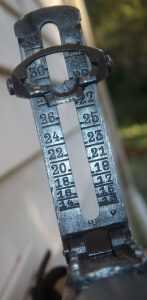
Here is the rear sight flipped up for shooting at some rather optimistic ranges-even after you convert the arshins to yards or meters.
The rear sight on the Model 1891 is more elaborate than later models of Mosin-Nagant rifles. It has something similar to the typical tangent rear sight, though it is graduated in arshins, an antiquated form of measurement that translates to about 28 inches. It is also possible to flip the sight leaf up 90 degrees, in a ladder sort of arrangement, for shooting at some rather optimistic ranges.
The bayonet for the Model 1891 is similar but different than the 91/30 bayonets. It is still has a triangular, needle type blade. It also has a sort of socket that goes over the barrel. Where it is different is the lock. Where the 91/30 bayonet has a spring loaded tab, the 1891 has a locking ring. Basically, you slide the socket over the barrel and rotate the ring to “lock” it behind the front sight. Mosin-Nagant bayonets, much like the rifles themselves, were not made to high tolerances. If you have a bayonet, it may require some fitting to properly attach. 91/30 bayonets will attach to 1891 rifles (if you aren’t concerned with being “period correct”) but not the other way around. The M91 bayonet that I have actually came with a 91/30 I bought later.
Caliber
In case you are wondering about what the designation actually means: “7.62” refers to the 7.62mm bullet, “54” refers to the 54mm casing length and the “r” notes that it is a rimmed case. While it is referred to as a 7.62mm, most weapons of this caliber are intended to use .310 diameter bullets rather than .308s as we are usually accustomed to in this country. For those that handload, this means that you can likely use the same bullets you use in that .303 SMLE or 7.7 Arisaka that you already load for. That said there are some exceptions, and there are some Mosin-Nagant rifles with bores sized for .308 bullets. So make sure you figure out what you have before you start loading. Also given the age of these rifles, if you are handloading for them be gentle. There is no good reason to hot load these.
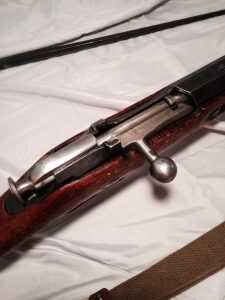
The action of the Mosin-Nagant rifle is very strong. During WWI, the Austrians even rechambered captured M91s to 8x50r without rebarreling them. In testing they found that the action would have no problem withstanding the added pressures of shoving an 8mm bullet down a 7.62mm bore, not that I would want to try, however!
The caliber itself also has quite a history. 7.62x54r was the first smokeless powder cartridge issued to the Russian Army. It is the longest running issued cartridge in the world, as it was first used in 1891 with the first Mosin-Nagant rifles, which were obviously Model 1891s. It is still in front-line service with the Russian army (and many others as well), with the SVD rifles and PKM machine guns chambered in it. This is really quite remarkable. To give you an idea, the US Army’s first smokeless cartridge was the .30-40 Krag, and it was issued at around the same time. Needless to say, we have changed cartridges several times since then.
In all of those years of service, the loading of the cartridge has changed several times. The original loading was a 212 grain round nose loaded to approximately 2020fps. In 1908, the Russians, like everyone else at that time, designed a pointed or “spitzer” bullet (this is what the common profile for rifle bullets are today) for the cartridge. It was 147grs and referred to as the “L” bullet(for light) and had a velocity of approximately 2800 fps. Ironically enough, that loading is what is still being loaded.
U.S. Army
All of this is great, but what does it have to do with the US Army? When the United States entered the war in 1917, there were not enough rifles to issue the rapidly growing American Expeditionary Force. In addition to rifles for the troops to carry into combat, weapons were needed for various stateside duties such as training (think teaching troops how to march), guard details, and similar tasks. At the same time, Remington-UMC and New England Westinghouse were stuck with a bunch of rifles, since the Bolsheviks both did not want to pay, and did not have the means anyway. This would have meant disaster had the US government not stepped in and purchased these rifles, both to prevent those companies from financial ruin (which was important given the US Army’s sudden need for vast amounts of small arms) and to help free up 1903s and 1917s to ship to the western front.

This is what the receiver markings on a Remington-UMC rifle are supposed to look like. photo courtesy of 7.62x54r.net
Rifle with accessories- Mosin-Nagant Model 1891, Bayonet, and Ammunition
Since these duties were not as ammunition intensive or as maintenance intensive as combat, obsolete weapons and non-standard weapons were used to fill these roles. Mosin-Nagant rifles were ideal for this purpose, being a military design and very durable. They were given the designation, “Russian Three-line Rifle, Caliber 7.62 mm. (.3 inch)”. As an interesting side note on stateside US duties: supposedly a small number of the US made M91s were modified to take the Pederson Device.
The Model 1891’s wartime service to the US does not end with stateside duty. When the Bolsheviks seized power in 1917, the Allies had already shipped a large amount of military aid to the Czar. It was decided that this war material should not fall into the hands of the revolutionaries. So the North Russia Expeditionary Force was formed. The US Army sent a contingent, the 339th Infantry. At that time, the US Army units of draftees would be formed of men from an area and trained in the region before being shipped out. So, different regiments had very distinct regional identities. This regiment was referred to as “Detroit’s Own” and its personnel came from the Midwest, which proved to be fortuitous given the harsh climate where they ended up being sent.
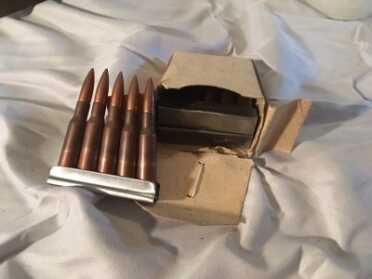
The ammunition issued to the troops in the North Russia campaign would’ve looked similar to this. It was loaded onto 5 round stripper clips, 3 clips to a box.
Because of a large amount of 7.62x54r ammunition already at the locations they were to be sent, the Americans traded their rifles in for Model 1891s. This was done to ease the logistics of deploying troops to such a far-flung location as Archangel. M91s were not exactly popular with American soldiers. They didn’t care for the bayonet, and the sights were considered crude in comparison to the 1903s. Also, in a lot of cases, soldiers found that the rifles were not properly zeroed. At that time marksmanship was highly stressed in training, and the normal US weapons were made with accuracy in mind in contrast to most of the other combatant nations involved in the war. But the M91s seem to have performed acceptably in combat anyway.
11:00 am on the 11th of November 1918, which marked the end of the fighting on the western front, came and went with no change for the soldiers fighting in what was essentially Siberia. The fought on until well into 1919 before being finally withdrawn and shipped home. Ironically enough, in spite of the purpose of the North Russia campaign, when the Americans left, they left their rifles to the Bolsheviks rather than bring them home.
The Story of a Rifle
This particular rifle is quite unique. It is definitely one of those “if it could talk, the stories it would tell” firearms. It is dated 1917. But most of the original markings were defaced from it. It looks as though someone took a punch or a chisel and peened over all of the manufacturer’s marks. I suspect that the fledgling Red Army was in dire need of weapons since the Russian Army was in pretty rough shape from its part on the Eastern Front. While this was the case, it wouldn’t do much for the propaganda of the new worker’s state, if the Red Army was using weapons made by nations that it was just fighting. The markings between different makers of Model 1891s were fairly distinctive. The peen marks on my rifle match up with where the letters would have been on a Remington made rifle, and no others interestingly enough.
[one_half]
[/one_half]
[one_half_last]

The markings on this rifle had been defaced sometime while it was in Russia. It was made by Remington-UMC.
[/one_half_last]
Since not very many of these rifles were actually issued, it is likely that it was captured at some point in time either during the fighting or after the withdraw of Allied troops from North Russia. Then sometime after 1986(since it has import marks, which weren’t put on surplus firearms until then) it was imported back to the US. I found it in a rural North Carolina gun shop, for a very reasonable price. At the time I bought this rifle, the 91/30s were cheap and readily available, and I almost didn’t give it a second look. Sometimes you can find a surprise hiding in plain sight, so keep an eye out.
Accuracy
While I was not exactly expecting 1 MOA out of a 100-year-old rifle, with ball ammunition, I figured I should shoot it anyway. For this, I used Tula 7.62x54r 148gr FMJ, since it’s fairly close to the same load as what this rifle was intended for. I would be amiss if I didn’t throw this safety statement in here: If you have an old rifle such as this, be sure to have it inspected to ensure that it is safe to fire before you attempt to do so. These rifles are 100 years old, so be careful with them.
I fired the rifle at 50 yards off of an improvised rest (prone supported, for all of you other military folks). I fired the first 5 round group to get an idea as to how well it would shoot, as well as the exact point of impact for this rifle. I had fired this rifle before, so I had a pretty good idea of where that would be. But I hadn’t ever tried to group in on paper. Given that the lowest sight setting is 400 arshins or about 311 yards, I expected the impact to be a few inches high, given the distance that I was shooting at. This is very common for bolt action military rifles. In the days before assault rifles and intermediate cartridges, it was thought that combat would likely be either at distances of several hundred yards or in bayonet range. As such the sights on rifles of this era generally start at 3-400. So if you decide you want to “paper” your old surplus rifle, make sure you have a big enough target to account for this.
My first 5 rounds settled in at about 3 ¾”. The point of impact was roughly about 2” high and right. I decided I would speed up my rate of fire a little bit and do a little “combat shooting” since this is a military rifle after all. I used a 6 o’ clock hold, to account for the sights. I kept all 5 rounds in the “head” portion of the target without a whole lot of effort. Not terrible for a 100-year-old rifle, with a so-so barrel.
Conclusion
After the war, the M91s still in the service of the US government were sold as surplus (along with a whole lot of other items no longer needed) to the American people. These appear to have been the first surplus Nagants for sale in the US. Now it’s beginning to look as though we’re seeing the last of them in any quantity. The Mosin-Nagant rifles have been like the $25 Lugers or $15 1903 Springfields for those of us who were born too late to see those gems. But occasionally you can find something extraordinary, even when you are looking a whole rifle rack worth of history.
***Check out GunsAmerica for your next Mosin-Nagant Rifle ***
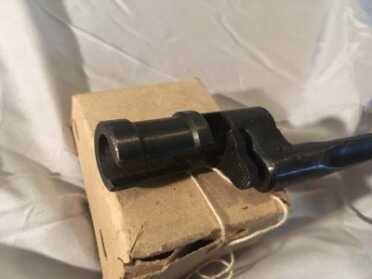
The latch on the 91/30 bayonet is a spring-loaded tab. This bayonet will also fit on an M91, but an M91 bayonet will not fit on a 91/30.



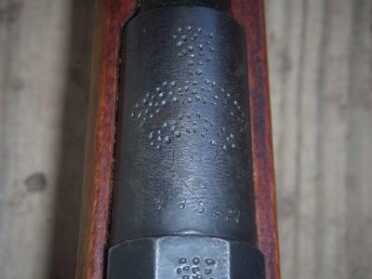
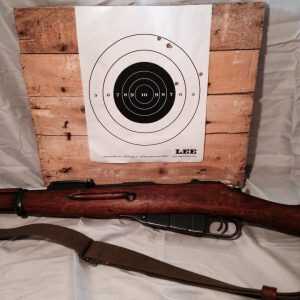
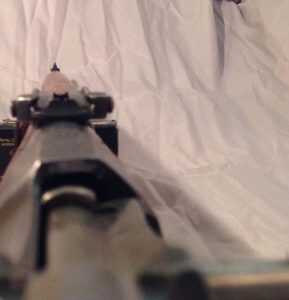
I was told that many Mosin Nagants have rear sights set in meters. The original load was a heavier round nose bullet. When the guns were converted to use the new spritzer bullet, the sights were often changed for the new bullet’s different ballistics. The original Lange style sight was marked with Russian letters and these sights used the old measurements. All 91/30 model sights are in meters.
I’ll make one more comment then let be. First, a tip of my Graf hat to the man who’s son was in the 3ID. I was too only it was in Germany then.
Back to these old rifles, often times the history is writ plain upon them. I have 2 91/30 MN’s. One, made in 1942 shows the effect of the “Enemy at the Gates.” The outer receiver is so rough it looks to have been cut with a chisel, and a dull one at that! But, it’s innards weresmooth enough- not slick by any means but it works perfectly, never binds up and is as accurate as can be expected with these old rifles and old ammo I use.
The other was made in 1943 when the Germans were beginning on their way out and it’s outer surfaces are plenty slick.
Another rifle I have is a post war Yugoslav Mauser- a 24/47. Some people look down their noses at refurbs (like the 91/30) and say they are nothing but defaced rifles and worthless. Well, that 24/47 has a number of grenade or mortar fagment divots in the barrel and a few holes in the stock with a fragment buried at the bottom of one such. Nothing would make me part with that rifle!
Nothing like that in these new fangled black rifles. I don’t begrudge them to those who enjoy such but, they are not for me!
You put good new/blog. Great to see Mosin Nagant for the USA army
Thank you for sharing this useful information.Rammy
DMA Inc.
I have my grandfather’s M1891. He was in the AEF- American Expeditionary Force- sent to France in WW1. There is a lot of info on the internet, including this M-N forum- http://www.russian-mosin-nagant.com His rifle was made by New England Westinghouse, under contract, if I recall correctly, to manufacture 3 million rifles, with Remington to make some 1.8 million. As the article states, after the Russian Revolution, the Bolsheviks didn’t want to pay for the rifles, leaving NEW/Rem. stuck with them. The US government stepped in, purchases the rifles, then sold many of them surplus for as little as $5-10 I read somewhere. I think this is probably how my grandfather picked this rifle up. I don’t ever recall him saying he carried it. I have his issued US M1917 bayonet, which would have fit the US 1903 in 30-06. He and my grandmother lived in the only house on the far side of a lake in Florida. He said he would leave it out on the dock, using it to shoot alligators. The rear sight is calibrated in archins as stated in the article. Russia had not gone metric yet. The rifle is a hoot to shoot- very smooth action. My grandfather told a story from WW2. Their home was near Camp Blanding in northern Florida, one of the largest Infantry training facilities in the USA back then, and Camp Blanding is still in use today by the Florida National Guard. He heard a rustling/voices outside at about 0500 or so, so he got up and found an Army patrol out on a night land navigation exercise- a bit lost. He put on some coffee, and knowing my grandmother, she probably made them all breakfast of eggs, bacon, and grits. They went out on the dock to see the view of the lake. A crow flies over- Granddad doesn’t like crows as they ate the grapes he planted in a small vineyard. He picks up the M91- said ‘it was the luckiest shot I ever made- a perfect “away” shot’ -that crow wasn’t moving in the sky, just getting smaller. He drops the crow with the M91- the one with the minimum range scale of 400 archins, or 311 yards….. The soldiers were so impressed, they wanted him to come out to Camp Blanding to teach marksmanship to the recruits! They are fun rifles- buy one if you can find a good one. Surplus ammo though is corrosive- so clean well. Our oldest son – 3rd Inf.Div. out of Ft. Stewart, Ga., spent 6 months over in Ukraine a couple of years ago teaching
the Ukrainian Army to defend themselves against Vladimir & Co. He said they are using a lot of WW2 ammo- have tons and tons of it- from artillery to rifles- all with highly corrosive, dirty gunpowder- they spend a lot of time cleaning weapons….
I have one made by Westinghouse any idea how much it’s worth.
I was shooting my M91 just yesterday. It was made by Ishevsk and inherited by the Finns somewhere along the way as indicated by their SA stamp. I’m surprised at your 50 yd target because mine at 75 (best I can squeeze out of my back yard), was somewhat better and it has to be the rifle because I’m in my medicated 60s with bad eyesight and none too steady hands. Must be greater familiarity with the weapon because I am no longer any great shakes of a shooter.
However, my M91’s socket bayonet has the 4 groove, spade tip bayonet just like the 91/30’s only difference being the locking ring. Btw, the lock ring bayonet was pretty common through most of the 18th & 19th centuries and was stadard issue for our Civil War’s 3 band rifle- muskets.
The verticle increments on the rear sight are not so ‘optomistic’ as you might think. The were not for sighting at individuals at those great ranges but rather for “volley fire.” Such was standard drill in the British army up through WWI. Any officer might call out a target such as “Trench in enfilade at 1500 yards, 5 rounds at my command… FIRE!” and the soldiers would pull up their rifles in the direction and range setting as indicated and crank off 5 rounds as fast as they could dropping a plunging fire at the indicated target. It could be quite effective in the absense of a machine gun.
Anyway- that’s a nice Mosin you have there. One of mine has a bolt made by Remington anyway.
I have had a number of these including some Finn reworks and really like them, The one I have hung on to in spite of the poor condition of the stock and missing metal is it’s a New England Westinghouse and sense some history to this piece, It has the Russian crest untouched, you might think well a leftover used by US Army. however it has import marks meaning it was brought in after being over seas. Other interesting features are the SA stamp of the Finnish Army on the side of the receiver and the stock is a 2 piece finger groove as used by the Finns. There is no documentation nor any way to verify but my pure guess is it was pressed into service by the soviets in the Winter War against the Finns without customary defacing of the Czar’s crest where it was picked up on by the Finns and put back into service by them. Anyway that is why I keep hanging on to this one,
I have two 1891’s, a 1928 Hex and a 1943 rounded receiver, that I scoped and installed Timney triggers. They group well, 1 to 2 inches at 100 yards, and I can ring a 18″x18″ steel target at 400 yards all day long. I also have a 1944 carbine that is totally original. Amazingly enough the trigger on the carbine is leaps and bounds above the original triggers from the 1891’s. Could be that many in the inaccuracies people find in Mosin’s is simply that you are dealing with decades of cosmoline and it takes hours and hours to get to a bright shiny bore. One of the products I learned about is Never Dull metal polish, available at your local Walmart in the automotive section, just add elbow grease.
I have both the full length rifle and the carbine version. Both shoot well, but the carbine will abuse you if you want to fire much more than a couple shots through it. The full length rifle on the other hand is reasonably pleasant to shoot for an extended session.
I used to have an FFL until the Obama Nazis stole my license. Over the years I had a license I sold a hundred or so of the M-44s, 60 or so of the 91/30s and a few of the sweet M-38s. I test fired most of them after a basic cleaning(5 rounds each) and found all but one to be right on the money at 100 yards, in a target about the size of a softball. That was with the sites set at the rearmost setting. As for the recoil; I found a slip-on recoil pad, Shooter’s Friend, Made by Rieken’s of Evansville, IN. It’s made of a silicon type material and I could shoot all day and not have a messed up should! It stretched over shotgun stocks and fit the small M-44 stocks with out slipping off. At the time the pad sold for about $20.00.
Chris, in this case, you would not be \”amiss\”, you would be \”remiss\”.
I\’m not a grammer nazi, I just don\’t want gun writers to sound uneducated.
“I’m not a grammer Nazi.” 🙂
Thank you I enjoyed the story of this old rifle. My grand father out of Nebraska serviced in WWI not sure if he used one or not. I do own one and have shot it , its a blast. Just getting it on paper may have been 5 shots as I remember. Its time to get it out again. I paid 99.00 for mine maybe 10 years ago.
Thanks
I have a few moisins m91 that I bought back in the 90s, and a spam can of ammo for them. The spam can is missing only ten rounds, because I found the rifle unpleasant to shoot compared to my 03 and various mausers. Compared to the glass smooth actions of the Mauser design, I thought that they should have issued the m91s with a rubber mallet to beat the bolt open with after each shot. It’s a dirt simple, crude, but functional, pig of a rifle that was probably worth every penny of the $75 that I paid for it. Now it’s a great wall hanger and interesting historical artifact.
Beating the bolt open on a Mosin is often due to cosmoline that got left in the chamber area and now almost glues the shell in the chamber. A 20ga bore brush and some solvent cured mine completely.
Another common cause of Mosin ‘sticky bolt syndrome” is the lacquer coating used on the steel cartridge casings. The lacquer builds up on the chamber walls eventually building up into a gummy layer. Bore cleaners will not remove it. Only ‘lacquer cleqaner’ will do that. Periodically screw a chamber brush on a rod section, chuck it up in a drill, dip the brush in lacquer thinner and spin it in the chamber dipping in thinner frequently until bore is cleaned. That will keep your bolt working smoothly.
Did I read that right? 7.62 ammo? Anybody price that stuff out lately?
It isn’t as cheap as it was just a few months ago – probably because of the dust up with Putin. Wolf ammo noncorrosive about 43 + cents a round. That stuff used to actually be cheaper than 22 ammo! To be clear, I’m talking about 7.62x54r ammo just like in the article.
WHEN THE SURPLUS MAUSERS , SWISS, ENFIELDS AND OTHERS RAND OUT AND WERE NO LONGER IMPORTED. ALL WE HAD LEFT WERE THE $90 MOSINS. NOW THE MOSINS ARE DRIED UP. I’D SOON CARRY AN OTHER RIFLE THAN A MOSIN WHICH IS $300 NOW. THE OTHERS ARE DOUBLE THAT. JMO
Roger, the point of the matter is not really to “carry” it at all. It is an antique and there is history. I liked what this author did, I am glad I bought mine. One original and one sporterized. ( I only got them as a friend was selling them and couldn’t get what he wanted at the local shop). These rifles are a hoot to shoot. They pack a punch and the ammo is really cheap. I use them just to blow up water jugs. When I shoot up the few hundred rounds I have, I will sell the sporterized one. If I need more room in my safe I might sell the other one but not likely. It would be a nice functional wall hanger.
Good article, thx!